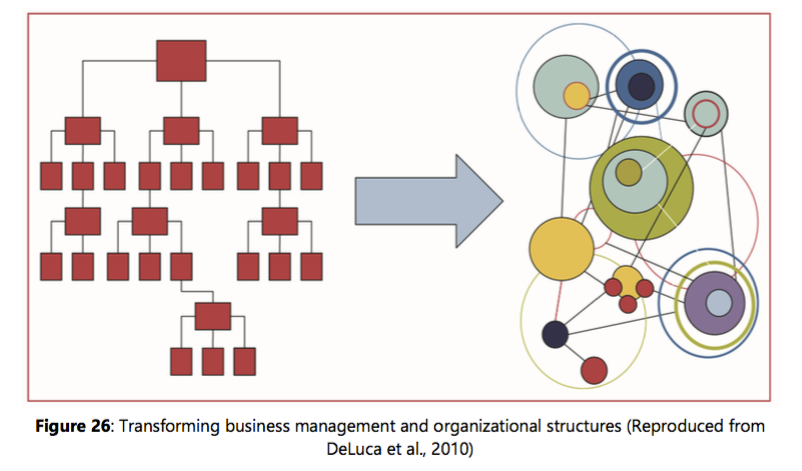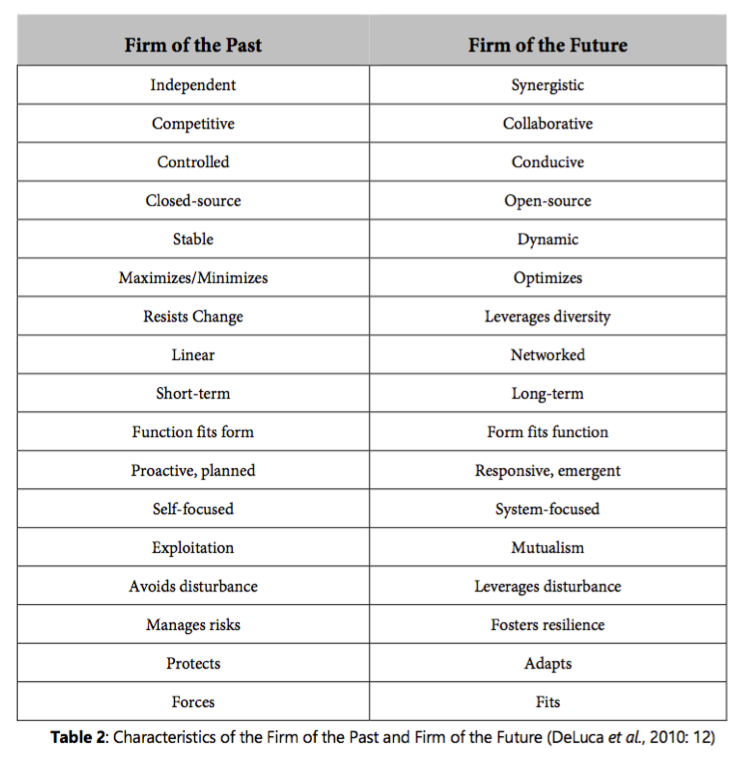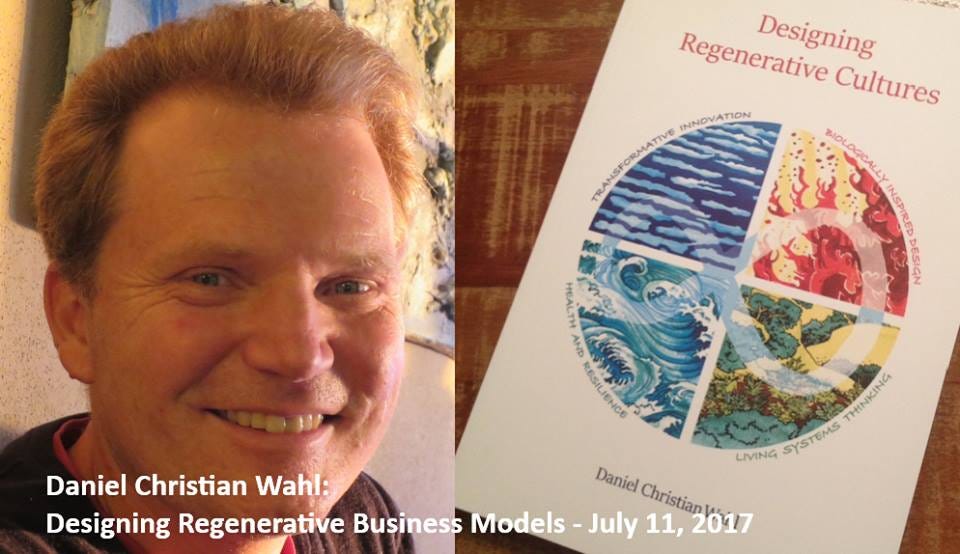Latest news about Bitcoin and all cryptocurrencies. Your daily crypto news habit.
Living the questions that initiate the transition to a commons-based collaborative economy describes transformative innovation from within the third horizon. It is an example of how H3 [the 3rd Horizon] is already present today but unevenly distributed. A fundamental transformation of our economic and monetary systems is becoming a necessity, if not inevitability. [This is an excerpt from Designing Regenerative Cultures. If you want an introduction to the 3 Horizon Framework for Transformative Innovation, click here.]
So, how can today’s businesses act in today’s conditions while at the same time engaging in their own transformation and the transformation of the economic environment they are operating in? Transformatively innovative (H2+) businesses have to be viable in the current economy and simultaneously transform the business ecosystems they participate in.
A plethora of disruptive green technological solutions are on offer. How do we avoid H2- pathways and innovations that will eventually be captured by the first horizon to maintain ‘business as usual’? There are immediate and diverse economic opportunities for regenerative businesses even under current economic conditions. How do we choose innovations that are truly transformative and lead us towards the third horizon and regenerative cultures? The goal is to create businesses that support win-win-win solutions, systemic health and collaborative networks that serve people and planet.
A fundamental pattern that defines regenerative living systems is the emergence of overall system health based on predominantly collaborative relationships among all the diverse participants of the system. Competition in such a system is about serving the whole system more effectively, rather than about who makes short-term gains at the expense of the collective and therefore to the long-term detriment of all.
In Holonomics: Business where People and Planet Matter, the authors argue that “we often have a mistaken view of competition, associating the word and its meaning with rivalry, the survival of one over the other”. They continue: “Indeed, a competitive process may result in the failure of one of the participants, but, when seen from the perspective of the system, it is part of the whole evolutionary process” (Robinson & Moares Robinson, 2014: 214).
Not all competitive interactions have a detrimental effect on whole-systems health, just as not all collaboration leads to regenerative systems. Reflecting on our own lives, how often has failure to achieve a certain goal caused disappointment in the short term and a deeper understanding of our true gifts and their more effective application in the long term? Healthy competition teaches individual participants about appropriate participation and how best to apply their unique skills and knowledge to optimizing the whole system. Some forms of competition within predominantly collaborative systems can be beneficial for all participants.
In general terms, within a regenerative socio-ecological system, businesses and individuals meet their objectives most effectively by nurturing the collaborative advantage that emerges from connecting previously separate or competing participants in synergistic ways — connecting unmet needs with spare or new capacities, so that everyone wins. Life evolves towards increasing complexity through favouring non-zero sum (win-win-win) relationships over zero-sum (win-lose) relationships (see Wright, 2001). Collaboration is life’s primary evolutionary strategy for the integration of diversity.
Strengthening collaborative (win-win-win) networks optimizes the system and builds social, ecological and economic capital. It prepares the system for disruptive events. As the ‘perfect storm’ of economic, political, cultural and ecological change is intensifying, strong networks of collaboration are better placed to weather the change ahead than isolated individuals or businesses.
Weathering the turbulent times ahead is about being embedded in wide networks of open information exchange with established means to keep competition ‘healthy’ — in support of optimizing the system as a whole. Such networks are based on collaborative relationships that value synergy and symbiosis, ensuring that information and mutual support flow rapidly, enabling us to respond with resilience, adapt appropriately and transform together when necessary.
The health and future of the planetary life support system and with it the future of humanity is at stake. Competitive strategies based on ‘them against us’ thinking will only delay our collective response and prove detrimental to all. At this stage of the game, either life as a whole wins and we stabilize and reverse global average temperature rise and halt rapid biodiversity loss, or nobody wins. All competitive wins will be short-lived. Business today has to serve all of humanity and life as a whole otherwise it will not effectively serve itself (in the mid- or the long term).
Transformative enterprises are based on the ecological insight that optimization of the whole provides long-term benefits while maximization of isolated parts only leads to short-lived and questionable ‘success’.
Collaborative businesses and regenerative business ecosystems will become the new mainstream of the third horizon. Ecologically inspired, collaborative businesses are capable of transforming the entire business ecosystem and the economic systems they operate in. How do we create such businesses? What can life teach us about business that creates conditions conducive to life? Giles Hutchins, a co-founder of ‘Biomimicry for Creative Innovation’ (BCI), explains:
[Nature’s Business Principles] are aimed at creating business conditions conducive to collaboration, adaptability, creativity, local attunement, multifunctionality and responsiveness; hence enhancing the evolution of organizations from rigid, tightly managed hierarchies to dynamic living organizations that thrive and flourish within ever-changing business, socio- economic and environmental conditions. Organizations that understand how to embed these principles from nature into their products, processes, policies and practices create greater abundance for themselves and their business ecosystems in times of rapid change, flourishing rather than perishing in volatile business conditions. Organizations inspired by nature are resilient, optimizing, adaptive, systems-based, values-led and life-supporting.Giles Hutchins (2012: 80–83)
The collaborators in the BCI network have used the list of ‘Life’s Principles’ developed by the Biomimicry Institute (see Chapter 6) and have turned them into “a set of business principles for the firm of the future” aiming to “provide a framework to guide successful transformation towards […] business inspired by nature” (ibid: 81). Here are just some of the questions that Nature of Business (2013) and Hutchins invite us to explore, as we aim to transform business to support the emergence of a regenerative culture with a regenerative economic system:
How can our business learn to use change and disturbance as opportunities rather than regarding them as threats?
How can we restructure to decentralize, distribute and diversify knowledge, resources, decision-making and action throughout the business?
How can we create a business culture that fosters diversity in people, relationships, ideas and approaches?
How can we optimize what we do by fitting form to function, embedding multiplicity in functions and responses, and building complex and diverse products and services from simple components and patterns?
How could we build a more adaptive business through appropriate information feedback loops, integrated cyclical processes and flexible responses to changes in resource availability?
How can we support the resilience of our business and its socio- ecological context by fostering synergies within communities, within energy, information and communication networks, enabling effective cyclical resource use?
How can our business contribute to the wider socio-ecological system by using values as the core driver towards positive outcomes, respecting and measuring what is valued rather than valuing what is measured?
How can our business become truly restorative by supporting life- building activity through leveraging information and innovation rather than energy and materials, creating mutually supportive health- generating relationships between individuals and ecosystems, and making environmentally benign and socially beneficial products?
I first had the privilege to be in an environment where these kind of questions were being formulated and explored during my 18 months at Schumacher College. Since 2001, I have seen the culturally transformative meme of ecologically inspired design and innovation spread from the fringe into the heart of business, government, academia and, most importantly, communities everywhere. Biological, ecological and systemic insights can inform the design and creation of sustainable and regenerative businesses. This is not a new insight, but one we are finally beginning to act on.
For more than two decades, business leaders in need of inspiration have been able to resort to insightful books exploring the what and how questions of sustainable business. Most offer Horizon 2 perspectives and intimate a diversity of visions for Horizon 3. Here are just some of the many publications that helped take such insights into boardrooms:
Recommended Reading for Business Leaders• Changing Course by Stephan Schmidheiny, 1992• The Ecology of Commerce by Paul Hawken, 1993• Factor Four by Ernst Ulrich von Weizsäcker, Amory & Hunter Lovins, 1997• Natural Step, by Karl-Henrik Robert, 1997• Believing Casandra by Alan AtKisson, 1999• Mid-Course Correction by Ray Anderson, 1999• Natural Capitalism by Paul Hawken, Amory Lovins and Hunter Lovins, 2000• Cradle to Cradle by William McDonough and Michael Braungart, 2001• Presence by P. Senge, O. Scharmer, J. Jaworski & Betty Sue Flowers, 2005• Green to Gold by Daniel C. Esty and Andrew S. Winston, 2006• Thinking in Systems by Donella Meadows, 2008• Theory U by C. Otto Scharmer, 2009• The Necessary Revolution by Peter Senge, 2010• The Blue Economy by Gunter Pauli, 2010• Reinventing Fire by Amory Lovins, 2011• The Zeronauts by John Elkington, 2012• The Up-cycle by William McDonough and Michael Braungart, 2013• The Nature of Business by Giles Hutchins, 2012• Holonomics by Simon Robinson and Maria Moares Robinson, 2014 • The B Corp Handbook by Ryan Honeyman, 2014
Some of these books focus more on business innovation and practice in the second horizon, while others explore the ‘future consciousness’ of the third horizon. [This list of book was edited out of the printed version of Designing Regenerative Cultures.] We are in the early phase of our learning journey into how to create regenerative businesses that create conditions conducive to life.
Business can be a powerful catalyst in the transition towards a regenerative culture, and we need both disruptive innovation of the H2+ type and transformative H3 innovation. Business leaders are recognizing that in a resource-constrained world, creating waste is a luxury that we can no longer afford.
As more people are becoming aware of the collateral damage associated with ‘business as usual’, customers everywhere are choosing businesses that are phasing out the pure ‘shareholder profit maximization’ model and, instead, are creating new ‘for social and ecological benefit’ business models.
In a rapidly changing world, nobody has definitive answers, but at least business leaders are now beginning to ‘live the questions’ — creating stepping stones towards a regenerative future.
Second horizon signs of hopeful change in the ‘mainstream’ include: a new generation of sustainability metrics that report ‘natural capital dependency’ not just carbon footprints, pioneered by market-leader Trucost; management tools like PUMA’s ‘Environmental Profit and Loss Account’ (co-developed with Trucost); the Circular Economy 100 Network; McKinsey’s call for a Resource Revolution (Heck & Rogers, 2014); many of the solutions show-cased by The Blue Economy (Pauli, 2010), AskNature and EthicalMarkets; for-benefit business models (Plan C, 2014 & Bocken et al., 2014), the WBCSD’s Vision 2050 (WBCSD, 2010), the work of CDP with Fortune 500 companies and investors (CDP, 2015), and the ‘B-team’ initiated by Richard Branson (B-Team, 2015). [See also: We Mean Business Alliance]
By January 2016, B-Corporation had certified 1,577 businesses from 42 countries and 130 industries to be a committed force for good in the world (B-Corporation, 2015). To find out how to convert your business into a B-Corp and learn from many good examples have a look at Ryan Honeyman’s recent book (2014).
The business world is changing rapidly in response to the accelerated environmental, technological, social and economic changes that are occurring all around us. Change is not only responsive to external forces; a key psychological driver is a deeper transformation fuelling people’s desire for meaningful work and for making a difference in the world. Fulfilling work means earning satisfaction from the meaningful impact of one’s work and not just earning more money. Together, we can find meaning in asking:
What would a truly regenerative business look like?
How can we create a business that restores ecosystems functions, regenerates bioproductivity, improves social solidarity and collaboration, and increases the health and wellbeing of our communities and ecosystems?
The Firm of the Future explores the major transformations that businesses and organizations will undergo in order to adapt to a changing world and in order to act more in tune with natural patterns. Figure 26 (below) illustrates the nature of this shift from linear hierarchies of control towards more flexible networks of collaboration.
The table on the next page from the same report compares and contrasts the firm of the past (a classical Horizon 1 business) with the firm of the future (a H2+ or even H3 business integrated in adaptive and regenerative business ecologies).
The H1 firms of the past were created from within the mindset dominated by the narrative of separation, whereas the H3 firms of the future will be expressions of the narrative of interbeing, recognizing the need for collaboration and regeneration as effective strategies to chart their paths into an unknowable future within a complex and turbulent world.
…
[This is an excerpt of a subchapter from Designing Regenerative Cultures, published by Triarchy Press, 2016.]
NOTE: Here is a recording of a conversation hosted by the Strongly Sustainable Business Model Working Group at OCAD on Regenerative Business Models and their context. You can follow this link to the OCAD site and recording. It takes about 90 seconds to load. The link again: https://connect.ocad.ca/p9irtsk22e4/?launcher=false&fcsContent=true&pbMode=normal&proto=true
Life’s collaborative lessons transform business was originally published in Hacker Noon on Medium, where people are continuing the conversation by highlighting and responding to this story.
Disclaimer
The views and opinions expressed in this article are solely those of the authors and do not reflect the views of Bitcoin Insider. Every investment and trading move involves risk - this is especially true for cryptocurrencies given their volatility. We strongly advise our readers to conduct their own research when making a decision.



